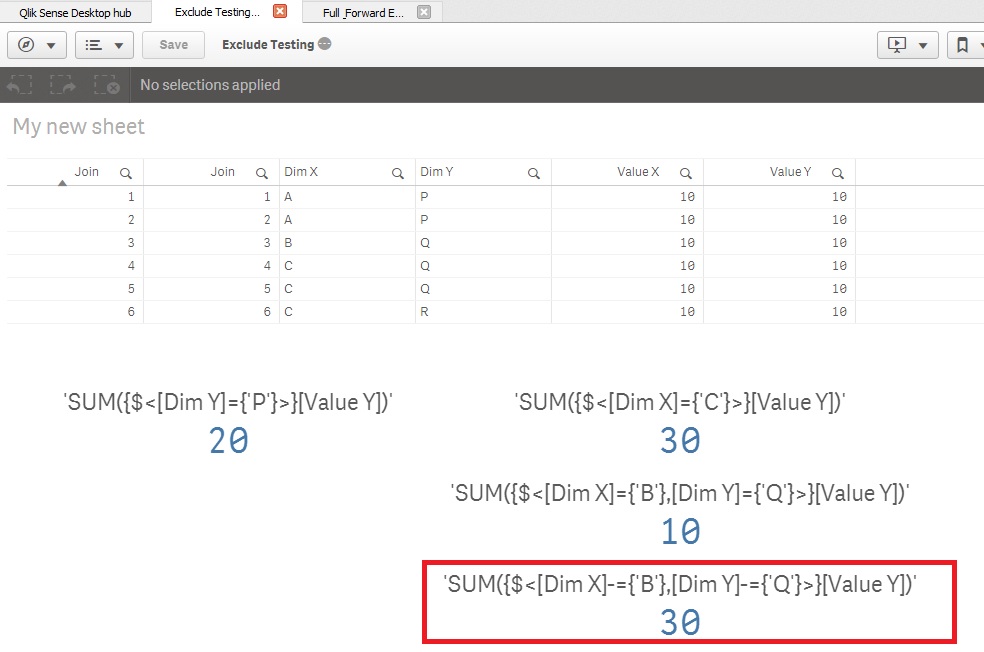Unlock a world of possibilities! Login now and discover the exclusive benefits awaiting you.
- Qlik Community
- :
- All Forums
- :
- QlikView App Dev
- :
- How to exclude dimension vales in set formula with...
- Subscribe to RSS Feed
- Mark Topic as New
- Mark Topic as Read
- Float this Topic for Current User
- Bookmark
- Subscribe
- Mute
- Printer Friendly Page
- Mark as New
- Bookmark
- Subscribe
- Mute
- Subscribe to RSS Feed
- Permalink
- Report Inappropriate Content
How to exclude dimension vales in set formula with AND clause?
Lets say i have two tables:
| Join | Dim X | Value X |
| 1 | A | 10 |
| 2 | A | 10 |
| 3 | B | 10 |
| 4 | C | 10 |
| 5 | C | 10 |
| 6 | C | 10 |
| Join | Dim Y | Value Y |
| 1 | P | 10 |
| 2 | P | 10 |
| 3 | Q | 10 |
| 4 | Q | 10 |
| 5 | Q | 10 |
| 6 | R | 10 |
Now I want to Calculate Sum(Value Y) where Dim X is not 'B' and Dim Y is not 'Q' . Hence I use this formula:
=SUM({$<[Dim X]-={'B'},[Dim Y]-={'Q'}>}[Value Y])
Which gives me value 30, but that's incorrect as it is executing OR condition.
I am looking for ''where Dim X is not 'B' and Dim Y is not 'Q' ", which should give me a value 50.
In other words, i want to exclude records where Dim X ='B' and Dim Y ='Q', and then calculated Sum([Value Y]) which is 50. How to do it?

Regards
SJ
- Tags:
- set analysis*
Accepted Solutions
- Mark as New
- Bookmark
- Subscribe
- Mute
- Subscribe to RSS Feed
- Permalink
- Report Inappropriate Content
I guess, you are getting it exactly opposite of the behavior. The expression is working as AND, and you need OR. Try like:
=SUM({$<[Dim X]-={'B'}>+<[Dim Y]-={'Q'}>}[Value Y])
- Mark as New
- Bookmark
- Subscribe
- Mute
- Subscribe to RSS Feed
- Permalink
- Report Inappropriate Content
I guess, you are getting it exactly opposite of the behavior. The expression is working as AND, and you need OR. Try like:
=SUM({$<[Dim X]-={'B'}>+<[Dim Y]-={'Q'}>}[Value Y])
- Mark as New
- Bookmark
- Subscribe
- Mute
- Subscribe to RSS Feed
- Permalink
- Report Inappropriate Content
Perfecto, thanks a lot! ![]()
- Mark as New
- Bookmark
- Subscribe
- Mute
- Subscribe to RSS Feed
- Permalink
- Report Inappropriate Content
My expression is working as OR, and I need AND. Your solution works perfectly in this case![]()
- Mark as New
- Bookmark
- Subscribe
- Mute
- Subscribe to RSS Feed
- Permalink
- Report Inappropriate Content
Any confusion?
Let me repeat and emphasis - if you write set like : <FieldA={'A'}, FieldB={'X'}> that means it is equivalent to If( FieldA='A' AND FieldB='X'). If you need to use OR, i.e. If( FieldA='A' OR FieldB='X')., set equivalent would be <FieldA={'A'}>+<FieldB={'X'}> .
<FieldA={'A'}, FieldB={'X'}> ~ If( FieldA='A' AND FieldB='X')
<FieldA={'A'}>+<FieldB={'X'}> ~ If( FieldA='A' OR FieldB='X')
Hope this is clear now.
- Mark as New
- Bookmark
- Subscribe
- Mute
- Subscribe to RSS Feed
- Permalink
- Report Inappropriate Content
Well, the way i see it working for me in QlikSense is :
<FieldA={'A'}, FieldB={'X'}> that means it is equivalent to If( FieldA='A' OR FieldB='X').
If you need to use AND, i.e. If( FieldA='A' AND FieldB='X').,
then set equivalent would be <FieldA={'A'}>+<FieldB={'X'}> .
- Mark as New
- Bookmark
- Subscribe
- Mute
- Subscribe to RSS Feed
- Permalink
- Report Inappropriate Content
I believe you are being confused, because you are using negative operator (that is exclusion) in set. Try with normal (inclusion - no negative sign) set analysis; that would clear your doubt.
- Mark as New
- Bookmark
- Subscribe
- Mute
- Subscribe to RSS Feed
- Permalink
- Report Inappropriate Content
i agree, got the poin